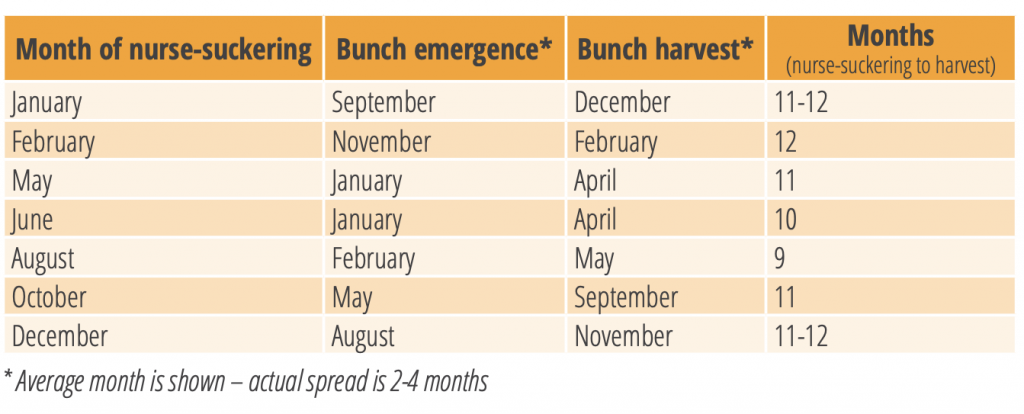Stewart Lindsay, Department of Agriculture and Fisheries
Banana producers in the Innisfail region severely affected by the cyclonic weather on 1 March will need to manage their crop cycling over the next few months to avoid a concentration of harvest when production returns.
Experience with severe cyclone impacts from TC Winifred, TC Larry and TC Yasi has shown that an industry-wide synchronisation of the cropping cycle happens when harvest resumes, if practices to spread the cropping are not implemented. The synchronising effect of these cyclones resulted in a year’s worth of harvest being concentrated into a 3-4 month period, meaning that affected farms generally cannot bell inject, bag or harvest all the fruit when it is mature. Following this the farms experienced a subsequent period with very low levels of fruit supply before the cycles start to smooth again. The effect is the same as if you have planted the entire area of the farm on a single day. The main options for staggering the return to cropping involve the use of replanting and nurse-suckering and growers need to make a plan for their particular property.
Step 1 – Assessing the damage to your blocks
The first step is to develop a clear idea of the damage to blocks on the farm.
• Identify blocks that have the greatest proportion of bunched plants still standing, or plants close to bunching, that will provide the earliest harvest.
• In blocks where the majority of bunched plants were blown over, assess the degree of height uniformity in following suckers. Each 30-40 cm difference in height is equivalent to about 1 month’s difference in growth, so if most of your following suckers in a block are between 2-3 metres high (i.e. all within 1 metre height of each other), then the probable spread of age for the plants is 3-4 months.
• Identify blocks you may wish to replant rather than restore – older blocks already earmarked for replacement or those with a high percentage of plants that have rolled out of the ground, or snapped close to ground level (more than 10%), that will leave “orphaned” suckers that will grow and yield poorly.
Step 2 – Deciding what practices should go on which blocks
Ultimately, deciding what interventions to make and how much to do is all about proportions – how much of your farm has plants of a similar height? The greater the degree of uniformity in plant height across the farm, the more important it is to intervene in the crop cycle to prevent a glut at harvest. Blocks with bunched plants and a high proportion of plants close to bunching could be retained for the fastest return to harvest.
Blocks that have a high proportion of the following suckers at a similar height should be identified, and if these are a significant proportion of the total farm, then some blocks will need to be nurse-suckered or replanted to spread the harvest.
Step 3 – Implementing and timing crop staggering practices
Basically, there are 3 main options – do nothing, nurse-suckering or replanting.
Nurse-suckering is a technique to manage uniformity and crop timing. It involves allowing a selected following sucker (the “nurse” sucker) to grow until it is at least 2 metres tall before killing its growing point. This forces the next generation of suckers to grow, from which a new following sucker is selected, and as a result the crop cycle is delayed by at least 3 months.
This technique offers the most flexible, cost-effective option for shifting the harvest cycles in the blocks being retained. There are a number of methods to achieve the death of the growing point, with the use of ethephon pseudostem injections being the easiest and most labour efficient. Ethephon injection into the pseudostem is covered by an APVMA minor use permit – PER14966 Ethephon bananas.
In our cyclone recovery trial conducted after TC Yasi we divided the trial area into quarters and aimed to have 25% of the production area return without any intervention, and the 3 remaining quarters were nurse-suckered at 3 different dates in 2011, aiming for overlapping harvests to spread and smooth supply.
Growers may not wish to go to 4 separate production timings but a minimum of 3 is probably needed – the “cyclone crop cycle” and then 2 subsequent scheduled crops.
The timing of your replanting or nurse-suckering will depend on the timing of the return to harvest, the seasonal conditions and the size of the plants. If most of the following suckers remaining in blocks range from 2-2.5 metres in March, then the probable date range for bunch emergence from these plants is mid-July to mid-December and will result in a heavy concentration of harvest in spring and summer, including the Christmas-New Year period. Most growers will want to avoid having too much fruit harvesting at this time of the year. However, scheduling harvest to the early months of 2022 puts production back into the highest cyclone risk period for bunched plants, emphasising the importance of having at least 3 scheduled cropping times to manage the market and climate risks. The table below summarises cropping data for different nurse-suckering times applied at the South Johnstone Research Facility in past trials.

